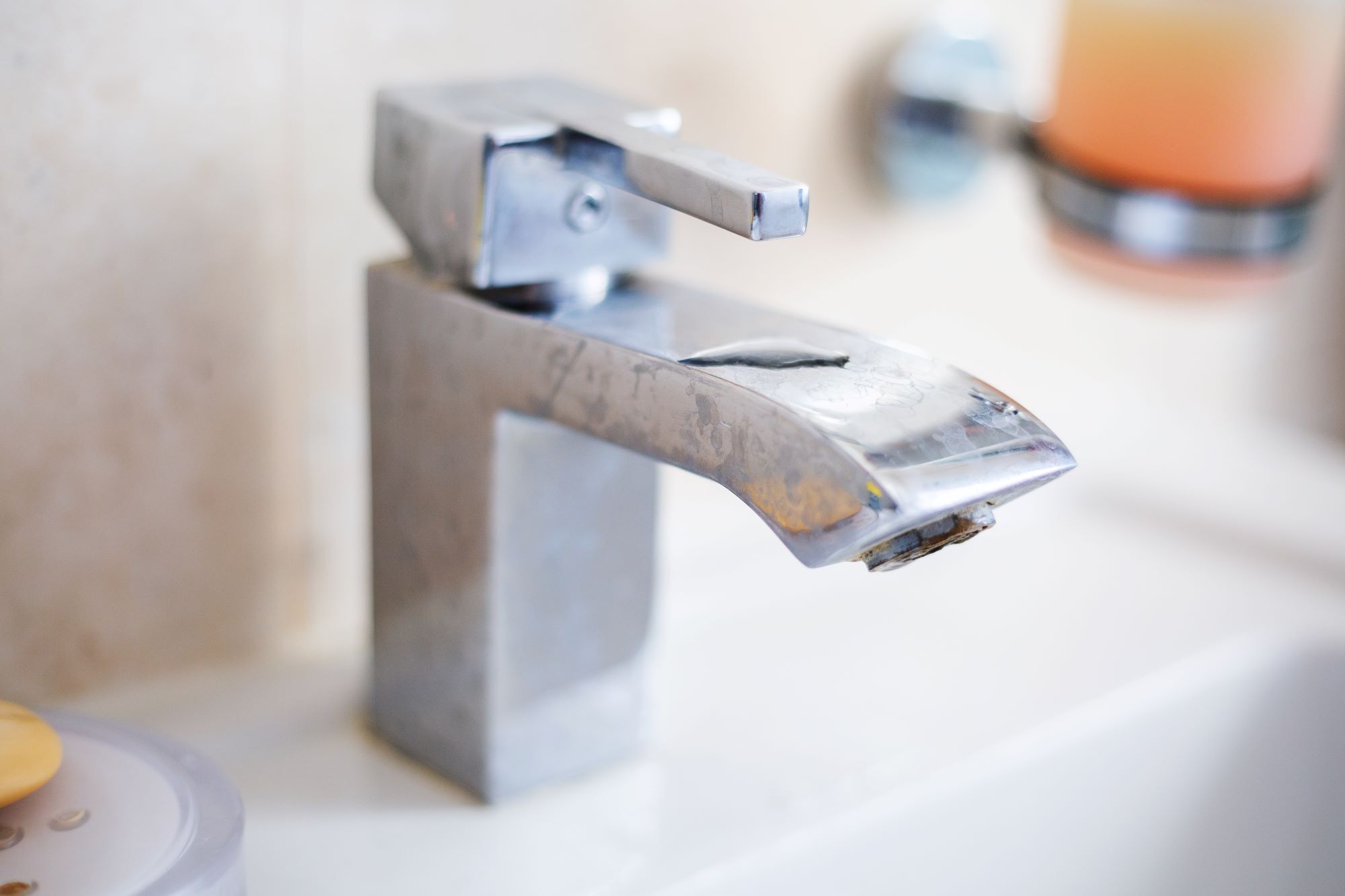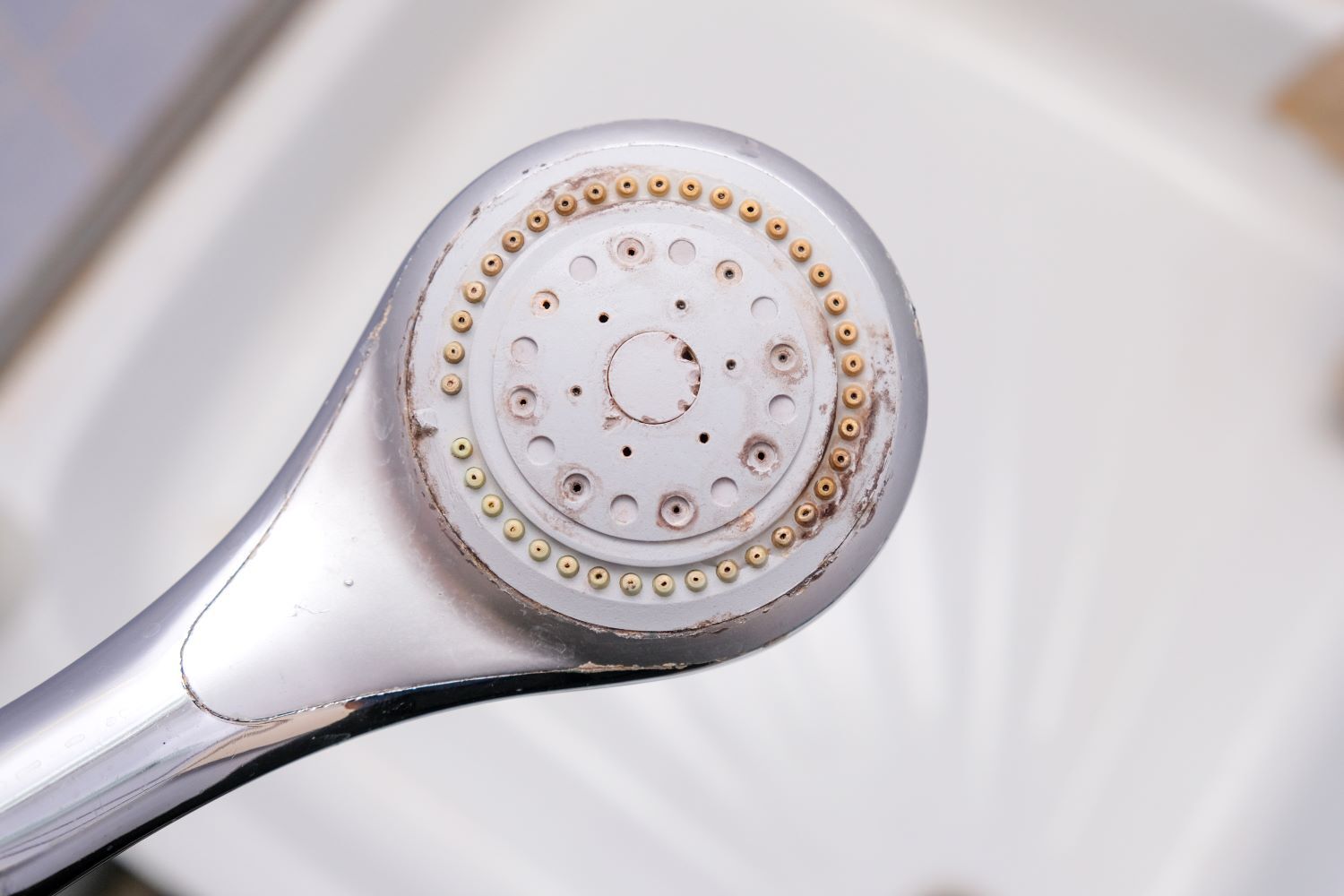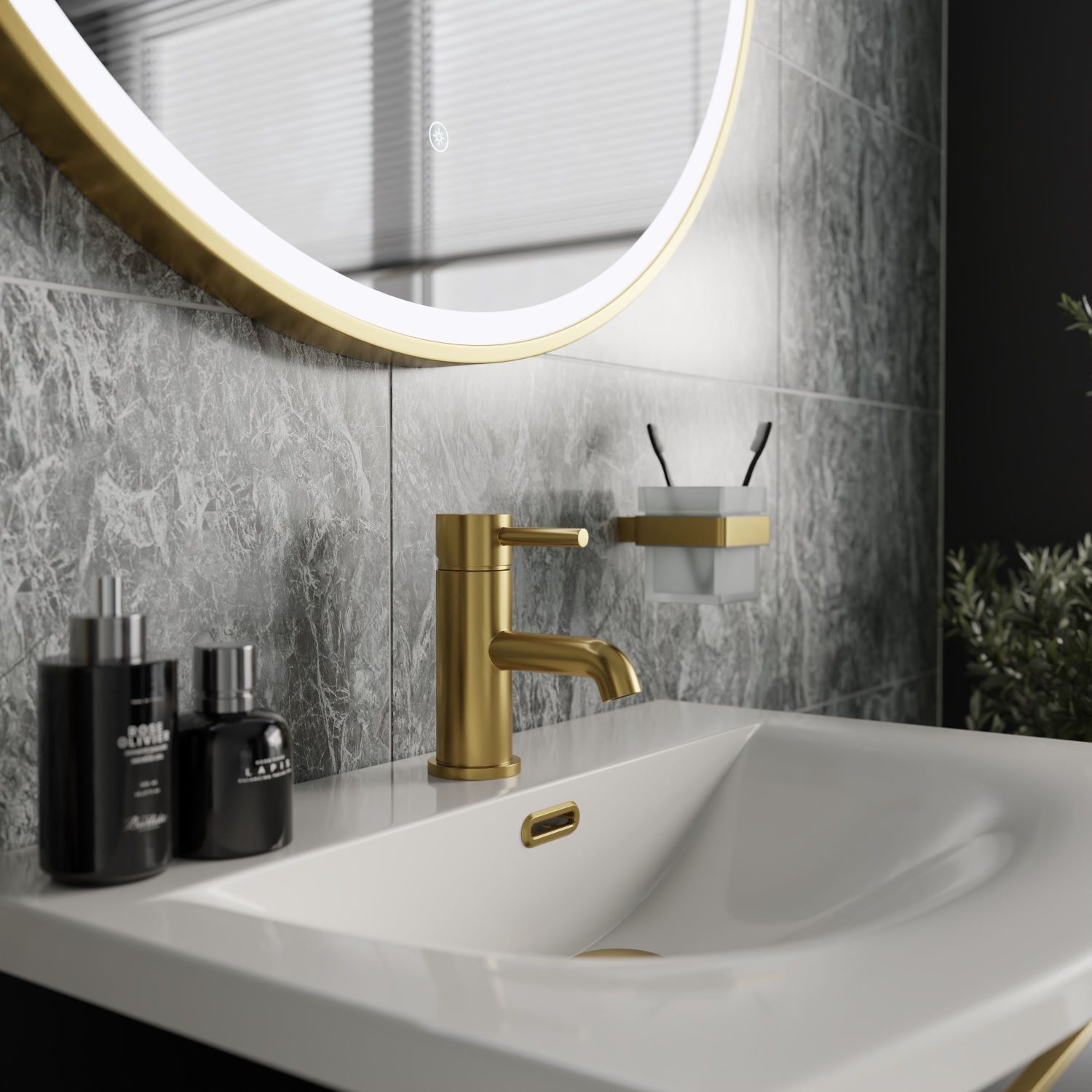Removing Bathroom Limescale: Simple Tricks to Keep Your Bathroom Spotless
3rd Apr 2025

Limescale is one of those frustrating bathroom problems that’s difficult to avoid. If you live in a hard water area, chances are you’ve already seen stubborn milky white marks on your taps or shower screen at some point.
Unfortunately, these can make your bathroom look dirty – even when you’re scrubbing it regularly – and getting rid of it isn’t always as straightforward as wiping your surfaces down.
The good news is that, with the right approach, removing limescale doesn’t have to be a battle. We’ll walk you through how to banish limescale from every inch of your bathroom with expert tips from Brian Toward, CEO here at Wholesale Domestic.
Contents
- What is limescale?
- Can limescale damage your bathroom?
- Simple tips to remove bathroom limescale
- How to avoid limescale build-up in 5 steps
What is limescale?

Limescale is a hard-to-remove, chalky substance often found on taps and shower screens. It’s made up of calcium carbonate, which is left behind when hard water evaporates. Over time, these mineral deposits build up, creating a rough, crusty texture that can be difficult to get rid of.
Limescale is especially common in bathrooms because of the high water usage. Any lingering droplets left to air-dry can leave behind mineral deposits that form limescale over time. While it might start as a cosmetic issue, too much limescale can also lead to blockages.
In hard water areas, like the South and East of England, limescale can build up quickly as the water supply contains more minerals. In these locations, it’s even more important to stay on top of your bathroom cleaning!
Can limescale damage your bathroom?
Limescale might start as a minor nuisance that’s all too easy to ignore, but it can lead to bigger issues if it’s not dealt with properly. While a thin layer on your taps or shower screen is mostly an eyesore, a heavy buildup can start affecting how well your fixtures work.
One of the most common problems is blocked pipes and showerheads. When limescale accumulates inside your plumbing, it can restrict how well water flows, leading to weak shower pressure and even temperature fluctuations. So, if you’ve noticed your shower suddenly turns cold mid-wash, limescale could be the culprit.
It can also take a toll on your taps. Limescale can wear down protective coatings, making metal fixtures look dull and, in extreme cases, lead to corrosion. If left untreated for a long time, it can even cause cracks in your pipework, so it’s important to act sooner rather than later.
Simple tips to remove bathroom limescale
Unfortunately, limescale typically appears in the most frustrating places – on the surface of your taps, inside your plumbing, and even lurking at the bottom of your toilet bowl. If you’ve ever spent time scrubbing those stains only for them to come straight back, you’re not alone.
Luckily, there are some simple tricks to get rid of limescale and keep it at bay. Whether you’re tackling a cloudy shower screen or a blocked tap, here’s everything you need to get started.
Tools to remove limescale in your bathroom
To remove limescale effectively, you’ll need:
- White vinegar*
- Lemon juice or fresh lemons*
- Baking soda
- Elastic bands
- Old cleaning cloths
- Microfibre cloth
- A spray bottle
- A bucket or washing-up bowl
- A cup
*Be careful when using white vinegar or lemon juice on plated bathroom fittings like showerheads and taps. Using them too often can damage the coating, so they should ideally be used once every couple of months.
How to remove limescale from your shower

Your shower creates the perfect environment for limescale – hot water, steam, and constant moisture. You’ll usually notice limescale forming as white, chalky streaks on your shower screen, a clogged-up showerhead, or tough, crusted deposits around your shower pipes and fixtures.
If you’ve tried scrubbing but it won’t budge, don’t worry. Using the citric acid naturally found in lemon or the acetic acid in white wine vinegar, bathroom limescale will soon be a thing of the past.
Here’s how to remove those stubborn stains from different areas of your shower:
How to remove limescale from shower screens
Wiping down your shower screen is one of the most easily forgotten tasks when deep cleaning your bathroom. This means it often develops quite a noticeable limescale buildup before you finally give in and try to remove it. Watermarks leave streaky patches across the surface, making your shower enclosure look dirty even after cleaning it.
Brian says: “You don’t need fancy sprays to get rid of limescale on your shower screen – white vinegar works just as well. Just fill a spray bottle with vinegar, spritz it over the shower glass, and leave it for a few minutes before wiping it away with a clean cloth. If you don’t have white vinegar, you can follow the same process with lemon juice instead.”
"If you're tackling stubborn stains, try mixing one part baking soda with two parts vinegar or lemon juice to form a paste. When combined, you'll notice a fizz – that's the reaction between the acidic vinegar and the alkaline baking soda, producing carbon dioxide. This is going to help break down the limescale and loosen it from the glass surface."
"Apply the paste to the glass, focusing on areas with heavy limescale buildup, and let it sit for a few minutes before rinsing and wiping away. A soft microfibre cloth is probably best for wiping to avoid scratching the glass. Plus, it will shine up your screen beautifully, leaving it streak-free and sparkling."
How to descale your showerhead
If your shower’s water pressure has dropped, or you’ve started to notice jets of water shooting off in the wrong direction, there’s a good chance limescale is blocking the nozzle holes.
Brian explains: “If you’re not sure how to descale a shower head, the best way is to soak it in a mix of warm water and vinegar. Just remove the showerhead, put it in a washing-up bowl or bucket, and add a 1:3 ratio of vinegar to water. Leave this to sit for 20-30 minutes, then rinse the showerhead thoroughly before reattaching.”
“If there’s a really bad buildup, you might need to scrub the shower head while it soaks using an old toothbrush. If there’s still limescale after the first soak, try repeating the process a couple of times.”
If you’re in a rush or can’t remove the showerhead completely, you can also tie a bag of water and vinegar around the showerhead using an elastic band.
How to remove limescale from shower pipes
Limescale inside your shower pipes and connections might not always be visible, but if left untreated, it can cause cracks or blockages over time.
Brian explains: “If you need to remove limescale from your shower pipes, a mix of vinegar and baking soda usually does the trick.”
“Start by unscrewing any removable sections of the shower hose, then soak them in a bowl or bucket with eight litres of vinegar and a cup of baking soda. This creates a strong reaction that’s perfect for unblocking limescale deposits inside the pipework. Leave them for half an hour, and rinse thoroughly with clean water before reattaching.”
How to remove limescale from taps

If your taps have started looking dull and chalky – or worse, they’re becoming stiff and hard to turn on and off – there’s a good chance limescale is responsible. This buildup can collect around the base of the taps, coat the handles, and even clog the spout, restricting the water flow over time.
Thankfully, removing limescale from taps is a fairly quick process.
How to remove limescale from tap handles and bases
Limescale usually gathers on the parts of the tap that are hardest to clean, like the grooves of the handles and around the base where water pools.
Brian says: “To tackle limescale around the base of the taps or on the handles, soak an old cloth in either white vinegar or lemon juice. Then, wrap it tightly around the affected area with an elastic band to secure it. Leave this on for at least an hour or overnight if the buildup is really bad.”
“Then, wipe away the residue with a clean cloth and gently rinse clean. Using a soft toothbrush to scrub the tap can also help get into any tight spaces.”
If you have plated taps (like chrome, brass, or gold), avoid using vinegar, which can damage the finish. Instead, stick to lemon juice or a gentle limescale remover solution designed for delicate surfaces.
It’s also best to avoid combining vinegar with baking soda for your taps, as this can scratch off the coating.
How to remove limescale from tap spouts
Limescale can also build up inside the tap’s aerator (the little nozzle at the end of the spout), which might restrict the water flow.
Brian explains: “If your tap is running slower than usual, there’s a good chance the aerator is clogged with limescale. One of the easiest ways to fix this is to soak the spout in vinegar.”
“To do this, fill a small cup with vinegar, place it under the tap to submerge the spout, and secure it using an elastic band. Leave it overnight, then give the nozzle a quick scrub with an old toothbrush before rinsing with clean water.”
For taps with a removable aerator, like a mixer tap, simply unscrew the aerator and soak it directly in vinegar for an hour. Finally, rinse thoroughly before you reattach it.
How to remove limescale from your toilet
Limescale buildup in your toilet isn’t just annoying to look at – it can also be one of the trickiest spots to clean. Over time, you might notice caked-on brown stains around the waterline or under the rim, and no amount of scrubbing with regular toilet cleaner seems to shift them.
This is because the minerals in hard water settle and solidify, creating thick deposits that cling to the bowl. Here’s how to remove it:
How to remove limescale from your toilet bowl
If you’re dealing with light limescale stains, try a simple vinegar solution or toilet bleach.
Brian says: “For smaller limescale deposits, mix a 1:3 ratio of white vinegar with warm water in a spray bottle. Spray the affected areas and leave them to sit for at least 30 minutes, then scrub with a toilet brush and flush. You can also try toilet bleach and leave it to sit for a couple of hours or overnight before flushing.”
If you don’t have either of these on hand, you might be surprised by how effective Coca-Cola is at removing lighter limescale buildups.
Brian explains: "It's true – Coke can be a great way to get rid of smaller limescale deposits, as it contains phosphoric acid, which is effective at breaking down limescale. When you apply it to the affected area, the acid reacts with the limescale, softening it and making it easier to wipe away."
Here's how to do it:
- Drain the toilet – Turn the isolation valve (usually located on the pipe behind the toilet) clockwise to shut off the water. Then, flush the toilet to empty the tank.
- Add the cola – Pour a full 1.25-litre bottle of Coca-Cola into the toilet bowl, ensuring it covers the limescale stains. If the stains are particularly high up, you might need multiple bottles. You don't need to use branded Coke – a cheaper version will do.
- Let it work – For the best results, allow the cola to sit for a few hours, or ideally overnight.
- Clean – After letting it sit, scrub the area thoroughly with a toilet brush to remove the limescale.
- Turn the water supply back on – Twist the isolation valve anti-clockwise to restore the water supply. Then, flush the toilet a couple of times to refill the tank and rinse away the cola.
Brian explains: "For particularly stubborn limescale deposits, a pumice stone can be incredibly effective. The naturally abrasive nature of the pumice helps loosen the limescale buildup."
"When scrubbing, just remember to use slow and controlled motions to avoid applying too much pressure, which could damage the surface. And always ensure the pumice stone is wet before you begin. This creates a slippery surface that helps prevent scratching the ceramic or porcelain."
How to remove limescale from under the toilet rim
The toilet rim is another spot where limescale likes to hide, and it can be easy to miss until it becomes a real problem that stops the toilet from flushing properly.
Brian says: “If you’ve got limescale forming under the rim, use a spray bottle filled with one part vinegar and three parts water and spray directly onto the problem areas. Leave this solution to work for at least an hour, then use a toilet brush or an old toothbrush to scrub away the residue. If the buildup is really bad, you might need to repeat the process a couple of times.”
How to avoid limescale build-up in 5 steps
Removing limescale is one thing, but keeping it away is another. Luckily, with a few simple habits, you can reduce how often you need to treat your bathroom.
Here are some easy ways to prevent bathroom limescale from building up in the first place:
- Wipe shower screens dry after use – Limescale forms when water evaporates, so the easiest way to stop it in its tracks is to remove the water before it can air-dry. Using a squeegee or microfibre cloth on your shower screen after each use prevents water marks and keeps your shower looking fresh for longer.
- Clean your showerhead regularly – Over time, limescale can block your showerhead’s nozzles, reducing water pressure. Soaking your showerhead in a bowl of white vinegar every couple of months breaks down any limescale before it becomes a problem.
- Fit a water softener – If you live in a hard water area, installing a water softener could make a big difference. These systems are fitted near your home’s water intake to filter out the minerals before they reach your taps and shower, stopping limescale from forming in the first place.
- Use a limescale-resistant spray – Some cleaning products create a protective layer over surfaces, slowing down the formation of limescale. Coating your taps, shower screen, and tiles with an anti-limescale spray helps keep them looking cleaner for longer. Reapply every couple of weeks for the best results.
- Treat your toilet bowl monthly – Limescale buildup in the toilet is one of the hardest to remove, so it’s much easier to prevent it before it starts. Pouring a cup of white vinegar into the toilet bowl once a month and leaving it overnight helps break down any forming limescale. You should also use a bleach product in your toilet bowl and scrub with a toilet brush a few times a week to keep limescale at bay.
Refresh your bathroom with Wholesale Domestic
Getting rid of bathroom limescale might feel like a never-ending task, but with the right approach, you can keep your taps, shower, and toilet sparkling clean.
If your bathroom fixtures have seen better days, it might be time for an upgrade. At Wholesale Domestic, we stock a wide range of taps, showerheads, and toilets to help you refresh your space.
Need more bathroom cleaning tips and inspiration? Check out our blog for expert advice.

 FREE delivery over £500*
FREE delivery over £500* Visit our showrooms
Visit our showrooms Finance options available*
Finance options available* Apply for a Trade Account
Apply for a Trade Account